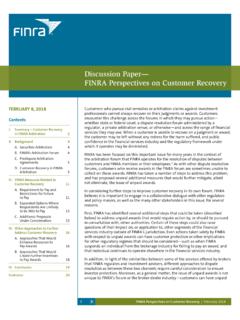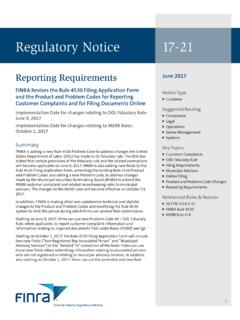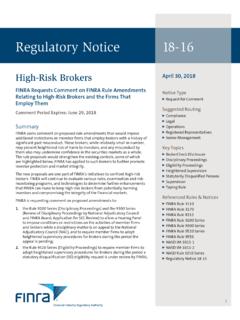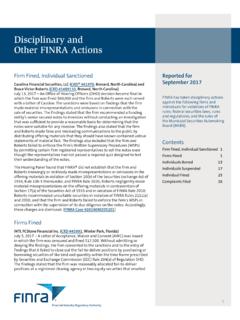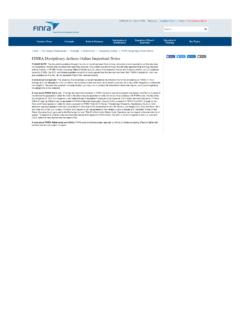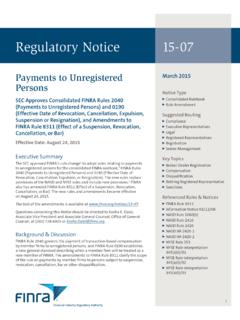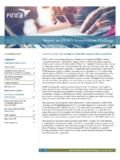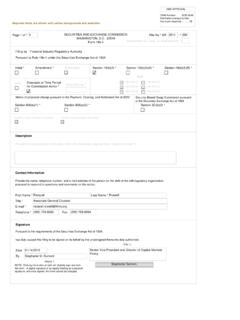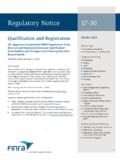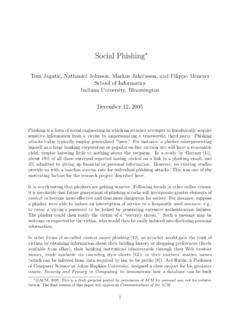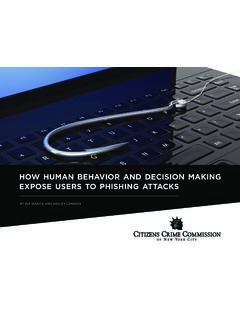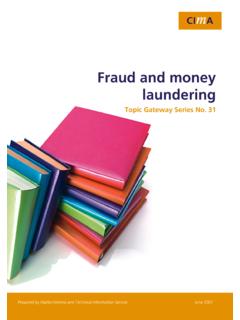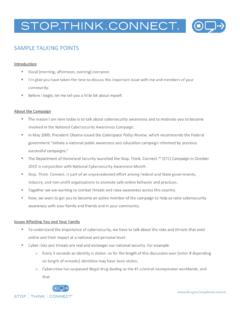Transcription of Report on Selected Cybersecurity Practices – 2018
1 Report on Selected Cybersecurity Practices 20181 ContentsBranch Controls 2 phishing 5 Insider Threats 8 Penetration Testing 13 Mobile Devices 14 Appendix: Core Cybersecurity Controls for Small Firms 17 Endnotes 19 DECEMBER 2018 IntroductionThis Report continues FINRA s efforts to share information that can help broker-dealer firms further develop their Cybersecurity programs. Firms routinely identify Cybersecurity as one of their primary operational risks. Similarly, FINRA continues to see problematic Cybersecurity Practices in its examination and risk monitoring program. This Report presents FINRA s observations regarding effective Practices that firms have implemented to address Selected Cybersecurity risks while recognizing that there is no one-size-fits-all approach to selecting the topics for this Report , FINRA considered the evolving Cybersecurity threat landscape, firms primary challenges and the most frequent Cybersecurity findings from our firm examination program.
2 First, we address how firms have strengthened their Cybersecurity controls in branch offices, which is especially important for firms with decentralized business models. Second, we discuss limiting phishing attacks, which remain a top Cybersecurity challenge for many firms. Third, we explain the importance of identifying and mitigating insider threats, which are of concern for many firms. Fourth, we describe the elements of a strong penetration testing program. Finally, we share observations regarding establishing and maintaining controls on mobile devices, which have emerged as a significant risk for many firms because of their increasingly widespread use by employees and customers. FINRA notes that the specific Practices highlighted in this Report should be evaluated in the context of a holistic firm-level Cybersecurity program.
3 FINRA s 2015 Report on Cybersecurity Practices addresses the elements of such Cybersecurity programs and provides guidance to firms seeking to improve their current protocols. Further, small firms seeking to develop or improve their Cybersecurity Practices should review the appendix to this Report Core Cybersecurity Controls for Small Firms. This appendix, combined with the FINRA Small Firm Cybersecurity Checklist will assist small firms in identifying possible Cybersecurity controls. This Report is not intended to express any legal position, and does not create any new legal requirements or change any existing regulatory regarding this Report may be directed to Carlo di Florio, Executive Vice President, Member Supervision/Shared Services, at (212) 858-3908 or or Steven Polansky, Senior Director, Member Supervision/Shared Services, at (202) 728-8331 or A Report FROM THE FINANCIAL INDUSTRY REGULATORY AUTHORITYR eport on Selected Cybersecurity Practices 2018 Report on Selected Cybersecurity Practices 2018 | December 20182 Branch ControlsFINRA has observed that some firms face challenges maintaining effective Cybersecurity controls at their branch locations.
4 Branches autonomy from the home office may adversely affect firms ability to implement a consistent firm-wide Cybersecurity program. Some firms may experience increased challenges if their branches may, for example, purchase their own assets, use non-approved vendors or not follow their firms software patching and upgrade protocols. Similarly, representatives working from home may require even further oversight and technological support to comply with firm standards. As a result, firms should evaluate whether they need to enhance their branch-focused Cybersecurity measures to maintain robust Cybersecurity controls and protect customer information across their has observed firms implementing the following effective Practices :00 Establishing Written Supervisory Procedures (WSPs) to define minimum Cybersecurity controls for branches and formalize oversight of branch offices; 00 Developing an inventory of branch-level data, software and hardware assets;00 Maintaining branch technical controls; and00 Implementing a robust branch Cybersecurity examination WSPsAlthough most firms have developed WSPs addressing Cybersecurity controls, FINRA has observed that branch offices may have less developed Cybersecurity controls in comparison to the home office.
5 In some cases, for example, firms may have distributed guidance on Cybersecurity to branches in a range of memos, newsletters, questionnaires and training, but may not have consolidated those into a comprehensive, easily referenced set of minimum standards or best Practices for their Other firms may not have formalized their oversight of branch offices administration of Cybersecurity has observed firms implementing the following effective Practices :00 Developing branch-level WSPs and other comprehensive guidance on Cybersecurity controls and distributing such guidance to all branches; 00 Distributing alerts and notifications on emerging Cybersecurity issues to both home office employees and branch representatives;00 Designating the branch office supervisor or another branch office staff member with responsibility for that branch s Cybersecurity controls;00 Providing branches a list of required and recommended hardware and software options and settings, as well as approved vendors;00 Mandating that branch personnel notify branch management of and properly respond to violations of firm Cybersecurity standards or material Cybersecurity incidents involving loss of confidentiality, availability or integrity of customer personally identifiable information (PII) or sensitive firm data (see Sections 11 and 12 of FINRA s Small Firm Cybersecurity Checklist); and00 Mandating that registered representatives complete an annual attestation to comply with the firm s WSP requirements, including its Cybersecurity policies.
6 Report on Selected Cybersecurity Practices 2018 | December 20183 Further, FINRA notes that training plays an integral role in improving the quality of branch-level Cybersecurity programs and controls. In particular, firms could consider requiring branch staff and registered representatives with access to customer information, as well as those working remotely, to complete initial onboarding, as well as ongoing, regular training on firm Cybersecurity standards, Practices and risks (in addition to their required firm continuing education (CE) program training).2 Ongoing training may include web-based or in-person courses, simulations of actual cases experienced by the firm or peer firms, security awareness bulletins and phishing or other campaigns. In order to determine the scope and depth of branch personnel training, firms may also consider incorporating into their training program a formal or informal evaluation of the staff s understanding of and compliance with firm Cybersecurity requirements.
7 See Section 8 of FINRA s Small Firm Cybersecurity Checklist for additional guidance on firm InventoryAsset inventories are a key element of any firm s Cybersecurity program, especially where branches autonomy may make it difficult for firms to know the scope of assets they need to protect. Branches and registered representatives may not be aware of the locations where they store sensitive customer or firm data; use unapproved software, hardware or vendor-provided services; or not comply with other firm Cybersecurity standards. An asset inventory can help reduce these risks and provide important information for managing branch office security controls. When used in conjunction with a Cybersecurity risk assessment, an asset inventory can serve as a starting point to identify critical assets and their vulnerability to attack, as well as appropriate policy, technical and physical controls to mitigate those further information on asset inventories, see Sections 1 and 8 of FINRA s Small Firm Cybersecurity Checklist and the Asset Inventories and Critical Assets discussion in FINRA s Report on Cybersecurity Practices .
8 FINRA has observed firms implementing the following effective Practices :00 Requiring branches to perform initial and recurring inventories of branch assets and update the firm regarding any changes;00 Identifying sensitive customer and firm information and the location(s) where such information is stored;00 Ensuring the physical security of branch assets;00 Establishing processes by which branches manage and Report lost or stolen assets;00 Providing secured asset disposal, such as destroying hard drives of computers no longer in use; and00 Ensuring branch operating systems are properly supported and maintained either by the firm or by on Selected Cybersecurity Practices 2018 | December 20184 Technical ControlsFirms face a variety of potential threats to their data and systems at the branch level. Firms can use a Cybersecurity risk assessment to determine which threats are most significant for each branch and, then, identify and implement appropriate technical (and other) controls to mitigate those FINRA has observed firms implementing the following effective Practices :00 Developing identity and access management protocols for registered representatives and other staff, including managing the granting, maintenance and termination of access to firm and customer data;00 Limiting registered representatives access to only their own customers data and related exception reports.
9 00 Setting minimum password requirements and multi-factor authentication for access to firm systems and applications by firm employees, registered representatives, vendors, contractors and other insiders (see Insider Threats section of this Report , below);00 Prohibiting the sharing of passwords among firm staff;00 Prohibiting the storage of sensitive customer or firm data in unapproved or prohibited locations ( , a file server, cloud provider or thumb drive and without encryption or transmitted without encryption);00 Establishing minimum encryption standards for all branch hardware used to access firm systems, including laptops, desktops, servers, mobile devices and removable media devices;00 Requiring branches to adhere to minimum encryption standards (and providing technical tools to enforce that standard) for data-in-transit, such as emails and file transfers that include customer PII or sensitive information;00 Ensuring branches use only secure, encrypted wireless settings for office and home networks;00 Maintaining regular patching, anti-virus protection, anti-malware and operating system updates for all branch computers and servers that access firm data in a manner that is consistent with firm, vendor and industry standards;00 Developing physical security protocols for all portable devices used to access firm data and systems, including laptops and mobile devices.
10 00 Mandating all branch vendors (including cloud providers) meet firm security requirements, especially if firm data or other sensitive information will be accessed or maintained by the vendor; and00 Creating processes and selecting firm-approved vendors for the secure disposal of hard copy records and firm computer hardware ( , hardware listed in the firm s inventory) that may contain sensitive further information on technical controls, see Sections 3 through 10 of FINRA s Small Firm Cybersecurity Checklist and FINRA s Report on Cybersecurity on Selected Cybersecurity Practices 2018 | December 20185 Branch Review ProgramFirms branch office reviews are an important tool to evaluate branches Cybersecurity vulnerabilities and ensure that branches are consistently applying Cybersecurity controls across a firm s branch network.
